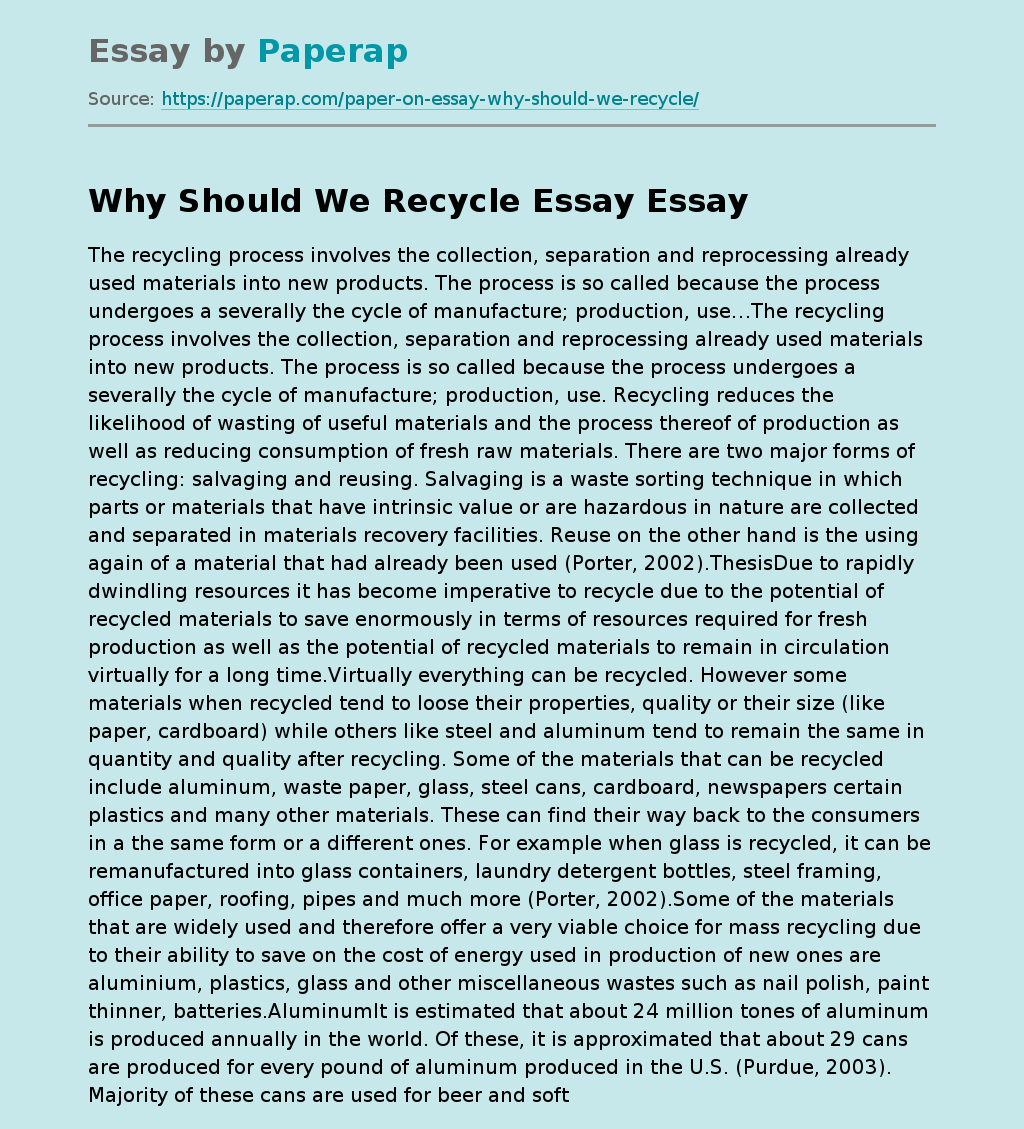Why Should We Recycle Essay
The recycling process involves the collection, separation and reprocessing already used materials into new products. The process is so called because the process undergoes a severally the cycle of manufacture; production, use…The recycling process involves the collection, separation and reprocessing already used materials into new products. The process is so called because the process undergoes a severally the cycle of manufacture; production, use. Recycling reduces the likelihood of wasting of useful materials and the process thereof of production as well as reducing consumption of fresh raw materials.
There are two major forms of recycling: salvaging and reusing. Salvaging is a waste sorting technique in which parts or materials that have intrinsic value or are hazardous in nature are collected and separated in materials recovery facilities. Reuse on the other hand is the using again of a material that had already been used (Porter, 2002).ThesisDue to rapidly dwindling resources it has become imperative to recycle due to the potential of recycled materials to save enormously in terms of resources required for fresh production as well as the potential of recycled materials to remain in circulation virtually for a long time.
Virtually everything can be recycled. However some materials when recycled tend to loose their properties, quality or their size (like paper, cardboard) while others like steel and aluminum tend to remain the same in quantity and quality after recycling. Some of the materials that can be recycled include aluminum, waste paper, glass, steel cans, cardboard, newspapers certain plastics and many other materials.
These can find their way back to the consumers in a the same form or a different ones. For example when glass is recycled, it can be remanufactured into glass containers, laundry detergent bottles, steel framing, office paper, roofing, pipes and much more (Porter, 2002).Some of the materials that are widely used and therefore offer a very viable choice for mass recycling due to their ability to save on the cost of energy used in production of new ones are aluminium, plastics, glass and other miscellaneous wastes such as nail polish, paint thinner, batteries.AluminumIt is estimated that about 24 million tones of aluminum is produced annually in the world. Of these, it is approximated that about 29 cans are produced for every pound of aluminum produced in the U.S. (Purdue, 2003). Majority of these cans are used for beer and soft drinks (99% of beer packaging is aluminum based while 97% soft drinks are packaged in aluminum cans) but only about 40% of the cans are post-consumer recycled (Donald, 2002). Given the fact that it requires only about 5% as much energy to recycle an aluminum can than when produced from virgin ore, there would be no need for mining new ores since about 3.1 million tones of aluminum waste is generated accounting for about 1.5% of the total municipal waste of the united states. There can be a sizable amount of savings if aluminum is completely recycled (Ackerman, 1996).PlasticsPlastic is the most used material on earth. It has been established that on average, an American car contains about 300pounds of plastic of about 60 different resins, about 10% of all the earnings of a grocery store are used to buy paper and plastic packaging. Cumulatively, plastic contributes about 23.9% (by volume) of all municipal waste in the U.S. however out of these only about 0.9 million tons of plastic (accounting for 4.7% of all the plastic used) were recycled (Purdue, 2003). The amount spent on manufacturing new plastic could have been reduced had all the plastic been recycled since there is no additional cost or energy required in recycling plastics (Donald, 2002).GlassAnnually about 41 billion glass containers were produced in the U.S. alone in shades of clear (about 64% of the total), brown (23%) and green (13%) this is according to research carried out by Purdue University (Purdue, 2003) in 1992.Glass containers are 64% clear, 23% brown, and 13% green. The glass generated a total waste of approximately 13.3 million tons of glass contributing 6.3% of total U.S municipal waste. Of these only 35% was recycled which is very low for a commodity which is said that one glass jar recycled can produce energy to power a 100watt light bulb for about four hours (Ackerman, 1996).Other miscellaneous wastesIt is this class of goods that produce most of the municipal waste of the U.S. while some of them cannot be classified under ‘recyclable’ goods, a significant amount can be salvaged or reused.The materials that end up in waste that could be better reused include durable goods, such as television sets, refrigerators and other home electronics which contributed about 16% of the U.S. municipal solid waste (by weight, 25.5 million tons of solid waste). The amount of energy used to make each component cannot be compared to the cost that can be incurred by producing a new one. Their mode of recycling can be sale by salvaging parts that can be reused (PA Department of Environmental Protection. 2008).Having looked at the various forms of materials and their benefits in terms of energy savings if they are recycled rather than produced from scratch, we can deduce that overall recycling affords the best solution to efficient use of available energy.
Why Should We Recycle Essay. (2019, Dec 05). Retrieved from https://paperap.com/paper-on-essay-why-should-we-recycle/

